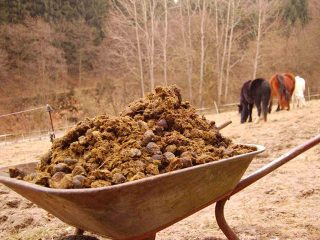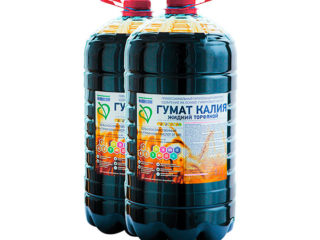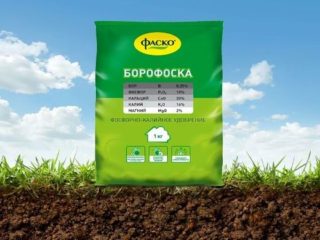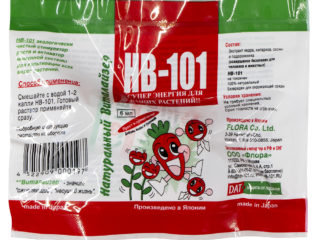Content
The instruction for the fungicide Azofos describes it as a contact agent, which is used to protect vegetable and fruit crops from most fungal and bacterial diseases. Spraying is usually carried out 2 times per season. The specific dosage and consumption of the solution depend not only on the culture, but also on the age of the tree, shrub, and also on the cultivated area.
Description of the drug
Azophos is a contact fungicide. This means that substances do not enter plant tissues - they remain on the surface of stems, leaves and other parts.
The composition of Azophos
The preparation contains a mixture of copper-containing ammonium phosphates (50%). Also, the fungicide contains mineral compounds of the following elements:
- nitrogen;
- zinc;
- magnesium;
- copper;
- potassium;
- phosphorus;
- molybdenum.
Azophos without potassium is not on sale. However, this trace element is always included in the composition of the fungicide. It plays an important role in the development of plants. When the dosage is observed, no side effects are observed.
Forms of issue
Fungicide Azophos is available in two main forms:
- A blue paste, of which 65% is occupied by the active ingredient (packed in plastic jars of 500 g).
- Aqueous suspension, i.e. suspension of solid particles in water (blue solution). Packaged in plastic bottles of different sizes.
Volume, ml | Weight, g |
470 | 580 |
940 | 1160 |

The most common form of release is an aqueous suspension in a plastic bottle.
What Azophos is used for
Fungicide Azophos is used for several purposes, the main of which is the prevention of the development of fungal and bacterial diseases:
- late blight;
- root rot;
- bacterioses;
- brown spotting;
- anthracnose;
- moniliosis;
- alternaria;
- septoria;
- scab;
- coccomycosis;
- phomopsis;
- clusteriosporiosis.
Due to its diverse composition, Azophos is used not only as a fungicide, but also as a foliar dressing for all types of crops. It contains basic trace elements that are well absorbed by plants in the form of an aqueous solution. In terms of the degree of impact, it can be compared with a complex mineral fertilizer.
Consumption rates
The standard dosage of this fungicide per 10 liters of water is:
- 100 ml of suspension;
- 75 ml of paste.
The use of Azophos in the form of a paste involves the selection of a smaller amount, since the concentration of the active substance in this case is 65% versus 50% for the suspension.
The consumption rate depends on the specific crop, as well as on the age of the plant. For example, for an adult apple tree, you need to spend 10 liters of working solution, while for a five-year tree - 2 liters.
Application rules
The use of Azophos in accordance with the norm guarantees the absence of negative consequences, which summer residents and farmers say in their reviews. The dosage and consumption of the solution must be carefully observed, since the drug is not only a fungicide, but also a foliar feeding. And an excess of fertilizer almost always harms the plants.
Terms and frequency of processing
The timing and frequency are culturally determined. Most often, 2 procedures are carried out - the use of Azophos in the spring and in the middle of summer.It happens that the multiplicity is increased to 3-4 (in the case of currants, plums, cherries, cherry plums).
The term also depends on the type of soil:
- In autumn, the use of Azophos is advisable if the land has a heavy clay structure or belongs to black soil.
- If the soil is light, the fungicide is applied for spring plowing (in April).
Preparation of the solution
Preparing a fungicide solution is quite simple:
- First, the required amount of solution or paste is measured.
- Then it is poured into 5 liters of tap water.
- Stir thoroughly and add the second half of the volume (up to 10 liters).
- Mix again and pour the liquid into a nebulizer (through a funnel).
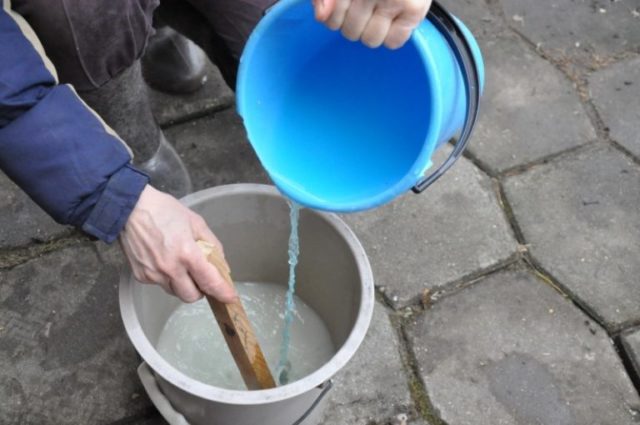
The drug is first dissolved in a small volume of water, then brought to 10 l
How to apply for processing
It is necessary to spray the fungicide exactly according to the instructions, observing the dosage. The rules for processing with Azophos do not depend on the season - the spring, summer and autumn procedures do not fundamentally differ.
Vegetable crops
Azophos is used for cucumbers, tomatoes and other vegetable crops. Consumption and multiplicity depend on the type of crop. For example, Azophos for potatoes is taken in an amount of 130-200 ml per bucket of water, and for cucumbers - only 10 ml.
Culture | Dosage, ml per 10 l | Multiplicity of treatments * | Waiting period ** |
Potatoes | 130 to 200 | 3 | 20 |
Greenhouse tomatoes | 130 to 200 | 2 | 8 |
Cucumbers in a greenhouse | 200 | 3 | 5 |
* Number of treatments per season. The minimum interval between them is 2 weeks.
** The number of days that must elapse from the last treatment with Azophos fungicide to harvest.
There are no strict restrictions on the processing time of plants. The instructions for the fungicide indicate that spraying should be carried out during the growing season, i.e. virtually at any stage of active growth. The consumption of the working solution depends on the area:
- Potatoes: 10 liters per 10 m2.
- Tomatoes: 2 liters per 10 m2.
- Cucumbers: 2 liters per 10 m2.
Fruit and berry crops
In the case of fruit and berry crops (for example, Azofos for strawberries), such rates of fungicide consumption have been established.
Culture | Dosage, ml per 10 l | Multiplicity of treatments | Waiting period |
Apple and pear | 100 | 2 | 20 |
Currant | 100 | 3 | 25 |
Strawberries, strawberries, raspberries | 100 | 2 | 25 |
Plum, cherry plum, cherry | 100 | 4 | 20 |
Cranberry | 100 | 1 | 70 |
Lingonberry | 100 | 1 | 70 |
Blueberry | 100 | 2 | 74 |
The consumption of the fungicide working solution depends on the age of the shrub or tree, as well as on the area:
- Apple tree up to 5 years old - 2 liters per seedling, older - up to 10 liters per hole.
- Cherry, cherry plum and plum - similar to the apple tree.
- Currants - 1-1.5 liters for each bush.
- Cranberries, blueberries and lingonberries - 3 liters per 100 m2.

Consumption for processing grapes: from 250 to 300 g per standard bucket of water (10 l)
Compatibility with other drugs
Azophos is compatible with most other pesticides, so it can be used in tank mixes. Exceptions are agents that provide an alkaline environment when dissolved. In this case, due to the exchange reaction, a precipitate forms.
Advantages and disadvantages
Among the main advantages of the fungicide Azophos, summer residents and farmers highlight the following points:
- The drug is effective enough - even one preventive treatment is enough to protect plants from fungal and other diseases.
- Means of universal use - can be used both on vegetable and fruit and berry crops.
- It acts not only as a fungicide, but also as a foliar feeding.
- Promotes an increase in plant resistance to diseases, temperature extremes.
- Stimulates the development of the root system.
- The fungicide is sold at an affordable price, especially in comparison with foreign counterparts.
- The product belongs to the 3rd class of toxicity. It is not dangerous for humans, animals, plants and beneficial insects.
- The components of the drug do not accumulate in the soil, so the fungicide can be used to treat the site for several years in a row.
At the same time, there are some disadvantages:
- The composition includes copper compounds in the form of a suspension of particles. They can clog the spray nozzles. This moment must be taken into account when machining the field.
- The finished solution should not be stored for more than 3 days.
- The rest of the mixture cannot be simply poured into the sewer and even more so into the reservoir. It is disposed of by special services.
- During the treatment of plants, the composition must be periodically stirred so that the suspension particles are evenly distributed throughout the volume.
Precautions
The fungicide belongs to the 3rd hazard class, i.e. is a moderately hazardous drug. Subject to safety precautions and processing rules (including dosage), the solution does not pose a danger to:
- human;
- pets;
- beneficial insects;
- plants.
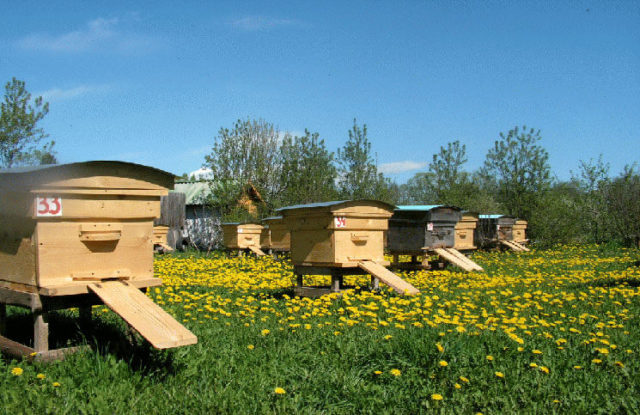
The fungicide is not dangerous for bees, so the treatment can be carried out in the area next to the apiary
Spraying plants can be done without a mask, glasses or special clothing. Do not be afraid of getting the liquid on your hands and other parts of the body - the drops can be easily washed off with soap and water. To avoid this, it is advisable to wear gloves. In case of contact with eyes, rinse with moderate water pressure.
If a solution of the fungicide Azofos gets inside, you should take several tablets of activated carbon and drink them with 1-2 glasses of water. In the event of extraneous symptoms (which is extremely rare), you need to see a doctor.
Storage rules
Fungicide Azophos must be stored in its original packaging at room temperature not exceeding 25 ° C, in a dark place with moderate humidity. It is necessary to exclude the access of children and pets.
The shelf life is 3 years (36 months) from the date of production. If the can or bottle is opened, the fungicide is good for 6 months. Therefore, in a personal household, you can use a small container, which can actually be consumed in 1 season.
Analogs
The analogs of Azophos include the following drugs:
- Nitroammofosk (increased sulfur content);
- Nitroammophos (fertilizer without added potassium);
- Nitrophoska (enriched with magnesium).
What is the difference between Azofos and Azofoska
The compositions of Azophos and Azofoska are similar to each other, therefore they are very often considered the same drug, believing that these words are synonymous. In fact, we are talking about different means:
- Azophos Is a fungicide. Therefore, it is used mainly for the treatment and prevention of fungal diseases of various cultures.
- Azofoska - fertilizer that is applied to the soil to improve plant nutrition.

The main difference between the products is that Azophos is a fungicide, and Azofoska is a fertilizer.
The preparations also differ in that the fungicide is always sprayed only on plants, and fertilizer is added directly to the soil. And since Azophos contains several basic trace elements, it can be considered a foliar feeding. At the same time, Azofoska is also a top dressing, but it is applied only by the root method.
Conclusion
The instruction for the fungicide Azofos contains basic information about the preparation and the exact dosages for each culture. The established norms should not be increased, since the drug works not only as a fungicide, but also as a fertilizer.It can be used on different plants, observing the interval between treatments for 2-3 weeks or more.
Reviews of gardeners about Azofos
